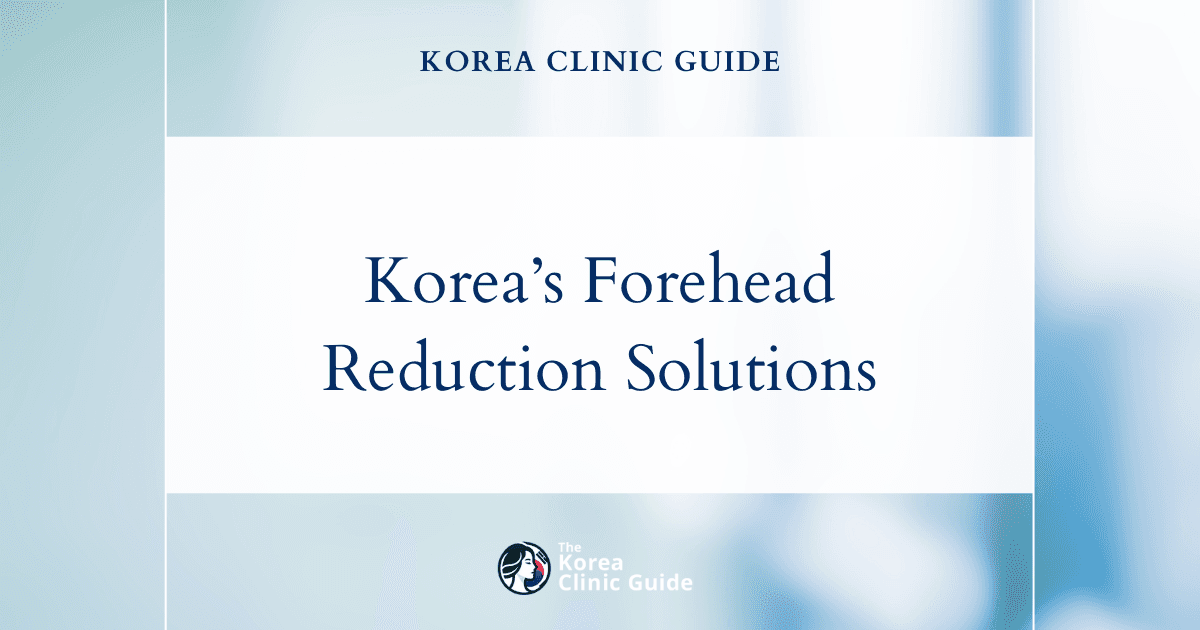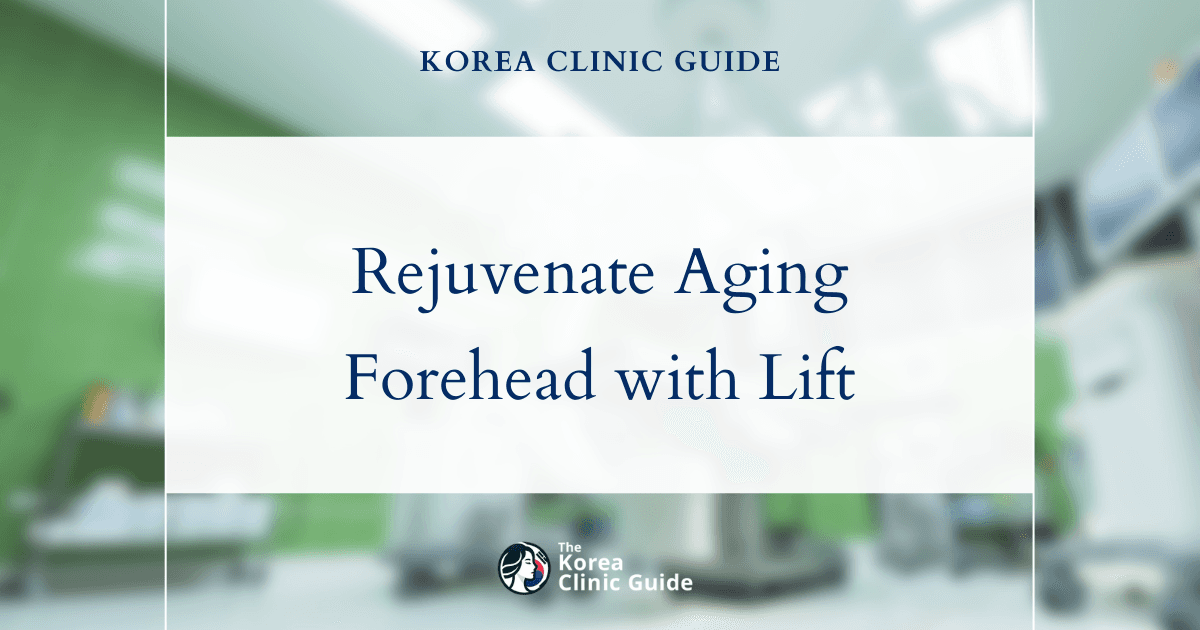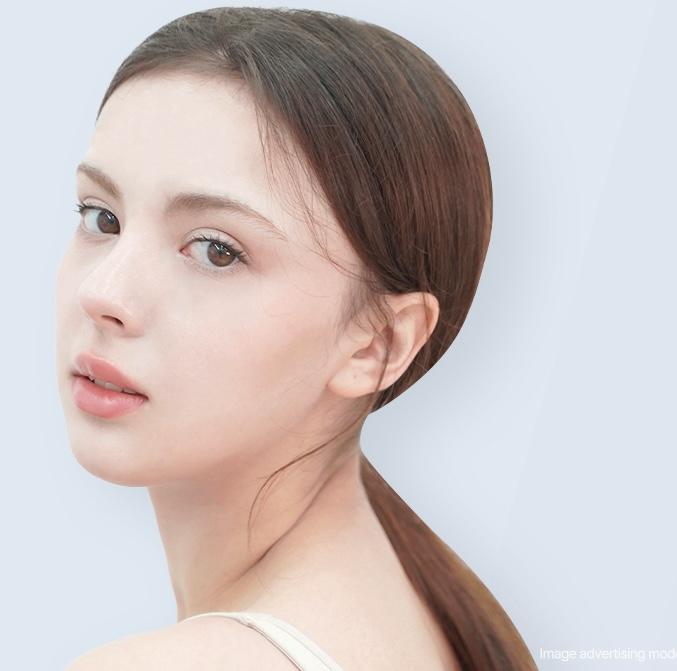Medical Tourism Blog
Korea’s Forehead Reduction Procedures: Effective Solutions for Wide Foreheads

Table of contents
- Understanding the "Wide Forehead" Concern
- Forehead Reduction (Hairline Lowering) Surgery: A Detailed Overview
- Best Clinics in Korea
- The Process of Undergoing Forehead Reduction in South Korea (for International Patients)
- Costs and Value: Forehead Reduction in South Korea vs. Other Countries
- Patient Experiences and Transformative Outcomes
- Conclusion
- References
This guide offers a thorough, evidence-based overview for anyone considering solutions for a "wide forehead," with a special focus on forehead reduction surgery. It combines medical facts, procedural insights, cost breakdowns, and patient experiences to help you make informed choices. The guide also highlights important points for those thinking about medical tourism, especially in South Korea.

Understanding the "Wide Forehead" Concern
A "wide forehead" usually refers to an aesthetic issue where the forehead appears too tall or disproportionately large compared to other facial features. This can show up as a high hairline or an elongated forehead, which may draw attention away from the rest of the face and disrupt facial balance.
Common Pseudonyms and Related Terms
In medical and cosmetic contexts, the term Hairline Lowering is the most common and medically accepted name for the surgery that addresses a wide forehead. Another term used is Foreheadplasty, which also refers to reducing an elongated forehead. Informally, some people might use slang like "coconut" to describe a prominent forehead, but these terms are not medically accurate.
It’s important not to confuse these with terms like "anti-wrinkle treatment" or "wrinkle relaxer," which often mistakenly get linked to forehead reduction but actually refer to treatments like Botox. Botox is a prescription medication with strict advertising rules, so using precise medical terms helps avoid confusion.
Another key distinction is between a cosmetic "wide forehead" and the medical condition called Frontal Bossing. Frontal bossing is a sign of underlying medical issues such as acromegaly, severe anemia, or rare syndromes, and involves changes in the bone and tissues of the skull. Unlike a cosmetic concern, frontal bossing requires medical treatment rather than surgery. It’s usually diagnosed in infancy or early childhood. Because these terms can be mixed up online, a thorough medical consultation is essential before considering cosmetic surgery. This ensures the right diagnosis and prevents pursuing cosmetic solutions for medical conditions.
Patient Perspectives and Psychological Impact
People who feel they have a large or high forehead often experience insecurity and self-consciousness. Many adopt hairstyles like bangs, wearing their hair down, or using caps to hide their forehead. These choices are more than style—they’re ways to cope with perceived flaws and avoid unwanted attention. Some patients share stories of being teased, which can deeply affect their confidence. A high forehead can also create the illusion of a receding hairline, making individuals feel older than they are. This shows that the impact of a wide forehead goes beyond looks—it affects daily life, self-expression, and emotional well-being. Addressing it can relieve emotional stress and improve quality of life.
Forehead Reduction (Hairline Lowering) Surgery: A Detailed Overview
Forehead reduction surgery, also called hairline lowering or hairline advancement, is a permanent cosmetic procedure that shortens the vertical height of the forehead. It works by moving the hair-bearing scalp forward, reducing the space between the eyebrows and the hairline. The goal is to create a more balanced and harmonious facial appearance. Typically, the hairline can be lowered by 2 to 4 centimeters, depending on factors like hairline height, scalp flexibility, and patient goals.
Ideal Candidates for the Surgery
The best candidates usually have a naturally high or large forehead and good scalp elasticity, meaning the scalp skin is flexible enough to be moved forward. They should also have thick hair and no active hair loss or family history of baldness, since the surgical scar is hidden by hair growth. If hair loss occurs later, the scar might become visible, affecting the aesthetic result.
Good overall health and realistic expectations are also important. Women often make ideal candidates because men tend to experience hairline recession over time, which could expose scars. It’s generally recommended to wait until your 20s or 30s before undergoing the procedure. For those with existing or expected hair loss, hair transplantation might be a better or complementary option.
Step-by-Step Surgical Process
Forehead reduction surgery is usually done under general anesthesia or IV sedation, sometimes with local anesthesia. The surgeon makes a precise incision along the new, lowered hairline and another at the original hairline. These incisions are designed to be hidden by hair growth.
The skin and tissue between the incisions are lifted, and excess forehead skin is removed. The scalp is then gently pulled forward to meet the new hairline and sutured in place. Surgeons take care to preserve hair follicles and nerves. Sometimes, the scalp is anchored to the bone or secured with endotine plates for extra lift. The surgery typically lasts 1.5 to 3 hours, depending on the extent of the procedure.
Expected Recovery Process
After surgery, a light compression bandage is placed to protect the area and reduce swelling. Most patients go home the same day without needing an overnight stay.
You can expect some pain, tightness, swelling, bruising, and mild headaches in the first few days. Swelling peaks around 1 to 2 days and gradually fades over 3 to 7 days, though minor swelling can last months. Sutures are usually removed 6 to 8 days after surgery, sometimes up to 14 days.
Most people resume normal, light activities within 1 to 2 weeks but should avoid strenuous exercise and activities that increase blood pressure for at least two weeks, sometimes up to six weeks. Hair washing should be gentle and delayed for a few days, using cool blow-drying and careful towel drying.
The incision will initially look pink but fades over 6 months to a year, becoming nearly invisible. Hair grows through the scar within 3 to 6 months, helping to hide it. While the lowered hairline is visible immediately, full healing and natural appearance take time, so patience is key.
Potential Risks and Complications
Forehead reduction surgery is generally safe with few risks. Temporary numbness behind the incision is common but usually resolves within weeks to months.
Unfavorable scarring occurs in less than 1% of cases. Temporary "shock" hair loss around the incision can happen but typically resolves within 6 months to a year. If hair follicles don’t recover, hair transplantation may be needed. Asymmetry can occur and might require corrective surgery. Infection is rare but antibiotics are often prescribed as a precaution.
Comparison with Alternative Solutions
Besides forehead reduction, Hair Transplantation (FUE or FUT) can reshape the hairline by adding follicles. It’s less invasive but takes longer (about 6 months) and may need multiple sessions. Hair transplantation is often combined with forehead reduction to refine the hairline.
A Brow Lift is another procedure sometimes done alongside hairline lowering to raise the eyebrows for a more youthful look.
Best Clinics in Korea
Listed below are the best clinics in Korea:
| Clinic Name | Key Features | Special Techniques |
|---|---|---|
| THEPLUS Plastic Surgery | Located in Garosu-gil, Gangnam, Seoul; team includes Dr. Kim (3D implants, rhinoplasty, facial contouring), Dr. Jeong (President of Korean Society of Plastic Surgeons, rhinoplasty), Dr. Lee (breast augmentation); four floors offering consultation, surgery, post-op care; active in research and education; focus on safety and personalized care | Rhinoplasty, facial contouring, 3D implants, breast augmentation |
| Made Young Plastic Surgery | Located in Gangnam, Seoul; emphasis on safety and excellence; offers face lifts, facial contouring, non-invasive lifting, rhinoplasty, eye surgeries; team includes plastic surgeons, anesthesiologists, medical staff; focus on natural, harmonious results and patient confidence | Face lifts, facial contouring, non-invasive lifting, rhinoplasty, specialized eye surgeries |
| Okay Plastic Surgery Clinic | Premier destination for wide-forehead-korea procedures; led by experienced female plastic surgeon; personalized treatment plans; services include hairline correction, forehead reduction, facial rejuvenation, scar management; focus on natural, harmonious results and long-term satisfaction | Hairline correction, forehead reduction, facial rejuvenation, scar management |
THEPLUS Plastic Surgery
THE PLUS Plastic Surgery clinic, located in the vibrant Garosu-gil area of Gangnam, Seoul, is recognized as a leader in advanced cosmetic and reconstructive procedures, including treatments for wide foreheads. The clinic is home to a team of highly respected surgeons, such as Dr. Kim, Dr. Jeong, and Dr. Lee, each bringing a wealth of expertise and international recognition to their respective specialties. Dr. Kim, a board-certified plastic surgeon and award-winning researcher in 3D implants, is renowned for his work in rhinoplasty and facial contouring, emphasizing the importance of facial harmony and natural beauty. Dr. Jeong, President of the Korean Society of Plastic Surgeons, is a global authority on rhinoplasty and is known for his philosophy of blending function with aesthetics. Dr. Lee, a specialist in breast augmentation, has an impressive background working at top hospitals and is dedicated to achieving natural, long-lasting results.
Spanning four floors, THE PLUS Plastic Surgery clinic offers a comprehensive range of services, from initial consultation to surgery and post-operative care, all within a modern and patient-centered environment. The clinic’s surgeons are not only skilled practitioners but also active contributors to academic research and education, frequently presenting at international conferences and publishing in leading medical journals. Their commitment to safety, patient satisfaction, and continuous professional development ensures that each client receives personalized care tailored to their unique needs. For those seeking expert solutions for wide foreheads or other facial concerns, THE PLUS Plastic Surgery stands out as a premier destination, combining cutting-edge techniques with a dedication to natural, harmonious results.
You can check out their website here: THEPLUS Plastic Surgery Website
Made Young Plastic Surgery
Made Young Plastic Surgery Clinic, located in Seoul’s renowned Gangnam district, stands at the forefront of aesthetic innovation and patient-centered care in Korea. The clinic is celebrated for its commitment to safety and excellence, blending traditional beauty ideals with the latest advancements in plastic surgery. Whether patients are seeking rejuvenation or a subtle enhancement, Made Young offers a comprehensive suite of procedures, including face lifts, facial contouring, non-invasive lifting, rhinoplasty, and specialized eye surgeries. Each treatment is meticulously designed to deliver natural, harmonious results while prioritizing patient safety and comfort.
The clinic’s team comprises highly skilled plastic surgeons, anesthesiologists, and dedicated medical staff, all united by a passion for helping patients achieve their aesthetic goals. Made Young’s approach goes beyond physical transformation; it aims to restore confidence and vitality, ensuring every patient leaves with a renewed sense of self. With its reputation for personalized care and outstanding outcomes, Made Young Plastic Surgery Clinic has become a trusted destination for those seeking wide-forehead correction and other advanced cosmetic procedures in Korea.
You can check out their website here: Made Young Plastic Surgery Website
Okay Plastic Surgery Clinic
Okay Plastic Surgery Clinic stands out as the premier destination for wide-forehead-korea procedures in Korea, thanks to its transformative and patient-centered approach to aesthetic care. The clinic is led by a team of specialized professionals, including a renowned female plastic surgeon with extensive experience, ensuring that every patient benefits from both expertise and empathy. At Okay Plastic Surgery Clinic, each treatment plan is meticulously tailored to the individual’s unique needs and aspirations, combining sincerity, precision, and the latest medical techniques. The clinic’s comprehensive range of services—from advanced hairline correction and forehead reduction to facial rejuvenation and scar management—reflects a commitment to holistic transformation rather than just isolated procedures. Patients can expect a supportive, expert-guided journey that prioritizes natural, harmonious results and long-term satisfaction, making Okay Plastic Surgery Clinic the best choice for those seeking wide-forehead-korea solutions in Korea.
You can check out their website here: Okay Plastic Surgery Clinic Website

The Process of Undergoing Forehead Reduction in South Korea (for International Patients)
South Korea is a top destination for plastic surgery, known for competitive prices, expert surgeons, and advanced facilities. Clinics are accredited, often have in-house anesthesiologists, and use cutting-edge technology comparable to the USA and Germany.
Pre-Procedure in South Korea
International patients usually start with an online consultation, submitting photos and questionnaires for an initial assessment and cost estimate. Upon arrival, an in-person consultation with the surgeon finalizes the plan based on a physical exam. Recent medical tests can be brought or done locally.
Patients must fast for 8 hours before surgery and avoid medications like Aspirin or Ibuprofen for two weeks prior to reduce bleeding risk. Showering before the clinic visit and arranging transportation or assistance after surgery is advised.
During the Procedure in South Korea
On surgery day, patients meet the surgeon twice to finalize the hairline design and address questions. After medical prep and sedation, the surgeon performs the operation, making incisions, removing excess tissue, and closing with sutures. Endotine plates may be used for extra lift.
Post-Procedure & Recovery in South Korea
A protective bandage is applied post-surgery, and patients recover in a room for several hours. Some may experience chills initially, but warming mattresses help comfort. Pain is managed with medications.
Most patients leave the clinic the same day, though some clinics offer optional overnight stays. Swelling peaks within 1-2 days and fades over the next week. Bandages are removed by nurses, and stitches typically come out around Day 14, sometimes earlier.
Patients can return to light activities within 2-3 days or up to 7-10 days but should avoid strenuous exercise longer. South Korea’s medical tourism system offers seamless care from consultation to recovery, with accredited clinics and advanced safety measures ensuring a smooth experience for international patients.
Costs and Value: Forehead Reduction in South Korea vs. Other Countries
Forehead reduction surgery in South Korea usually costs between $2,400 and $7,000 USD (₩3,500,000 to ₩10,174,000). Average prices for "Forehead Contouring," which includes hairline lowering, hover around $2,967 USD, based on Bookimed data.
What is Typically Included in the Cost (in Korea)
- Consultation Fees: Initial surgeon consultations are usually included.
- Post-operative Care: Follow-up visits for healing checks and suture removal.
- Medication: Pain relief, swelling reduction, and antibiotics.
Additional Expenses for Medical Tourists (Typically Excluded)
- Travel: Airfare ($800-$1,500 from the US), accommodation ($20-$200+ per night), local transport ($1 per subway ride), and meals ($10-$50+ daily).
- Other Costs: Travel insurance ($50-$200), communication (SIM cards or phone plans starting at $30), and sightseeing expenses if patients explore Korea.
Comparative Cost Analysis of Forehead Reduction Surgery
| Procedure | South Korea (USD) | United States (USD) | Europe (USD)* | Thailand (USD)* | Turkey (USD) | Mexico (USD) | Hungary (USD) |
|---|---|---|---|---|---|---|---|
| Forehead Reduction / Hairline Lowering | $2,400 - $7,000 | $4,000 - $6,000 | $2,500 - $15,000 (Proxy) | $1,500 - $8,000 (Proxy) | $3,500 - $7,000 | $2,000 - $3,000 | $3,000 - $4,000 |
*Proxy costs for Europe and Thailand are based on related facial contouring or eyelid surgery prices, as direct forehead reduction costs were not explicitly available.
Factors Influencing Cost Variations
Costs vary based on the surgeon’s experience and reputation, clinic location and prestige, surgical techniques and technology used, and the patient’s specific needs.
The Value Proposition of South Korea
South Korea offers a great balance of affordability, quality, and expertise. Korean surgeons are highly trained, especially in Asian facial features. Competitive pricing reflects high procedure volumes and efficient healthcare systems, not lower quality.
Prices often include consultations, post-op care, and medication, providing transparency. While some countries like Mexico or Hungary may offer lower base prices, South Korea’s world-class standards, advanced facilities, and experienced surgeons make it a top choice. It offers a "value sweet spot" for patients seeking quality and cost-effectiveness, supported by medical tourism agencies that provide personalized care and logistics.
Patient Experiences and Transformative Outcomes
Many patients choose forehead reduction to address feelings of insecurity about a "long" or "big" forehead. They often want to stop relying on hairstyles like bangs to hide their forehead and feel younger and more balanced.
Reported Improvements in Facial Balance and Aesthetics
Patients consistently report a more proportional, youthful, and attractive appearance after surgery. The hairline looks natural and lower, and excess forehead skin and wrinkles are often reduced.
Impact on Self-Esteem and Confidence
A major benefit is increased self-confidence. Patients feel free to go without bangs and more comfortable in their appearance. The surgery not only changes physical features but also improves self-image and psychological well-being, freeing patients from previous insecurities.
Addressing Common Concerns During Recovery
Concerns about scarring, hair loss, and numbness are common. Scars fade over 6 months to a year and are hidden by new hair growth. Some patients use microneedling to blend scars. Temporary "shock" hair loss usually resolves within a year. Numbness is temporary and improves as nerves heal.
While the new hairline is visible immediately, full natural results take months to a year. Patients should have realistic expectations and patience during recovery.
Long-Term Satisfaction and Quality of Life Improvements
Results are permanent, and patients report high satisfaction, happiness, and improved quality of life. The surgery helps balance facial features and relieve long-standing insecurities.
Conclusion
Forehead reduction surgery provides a lasting solution for those bothered by a high or large forehead, enhancing facial balance and boosting confidence. Ideal candidates have good scalp elasticity and stable hair health to ensure the best long-term results and scar concealment. Understanding the difference between cosmetic concerns and medical conditions like frontal bossing is essential, making thorough medical consultation a must. South Korea stands out as a top destination for this surgery, offering expert care, advanced facilities, and competitive pricing with comprehensive support for international patients. Careful planning and realistic expectations are key to a successful and satisfying outcome.
References
1, 2, 3, 4, 5, 6, 7, 8, 9, 10, 11, 12, 13, 14, 15, 16, 17, 18, 19, 20, 21, 22, 23, 24















